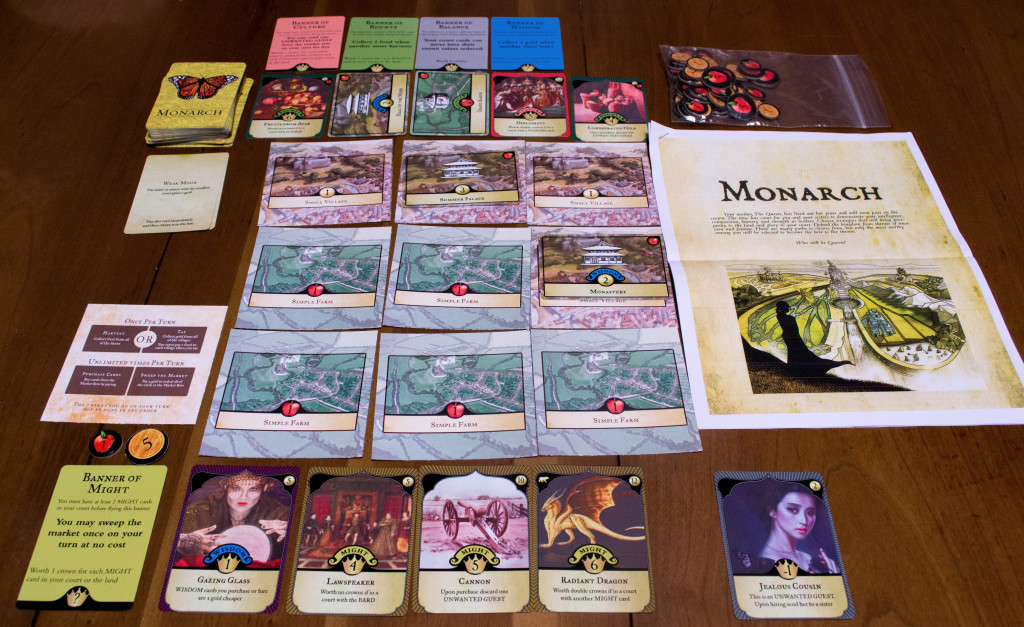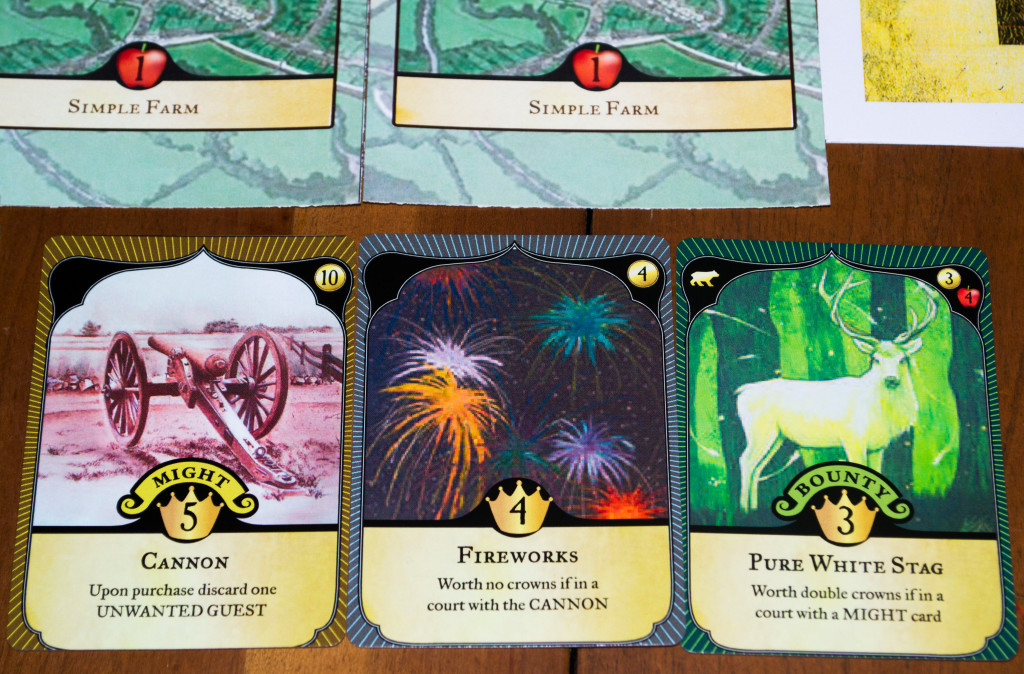In July of 2013 I had the pleasure of conversing with the folks at Tiltfactor and reviewed three of their games: “ZOMBIEPOX“, “Awkward Moment“, and “Buffalo“. All three received above-average review scores, the general consensus being that they were very easy to pick up and play. In “Monarch” (a game by Dr. Mary Flanagan, Founder of Tiltfactor), players will be assuming the roles of “sisters”, all of whom are competing to be the next Queen. By obtaining Court Cards that in turn award Crowns (points), players can achieve exactly that. The game will be seeking funding through the Kickstarter process on 2/9/15, so go check it out and support it if you like what you see here today (link below). Before we begin, I’d like to quickly thank Max Seidman from Tiltfactor for providing me with a prototype copy for preview purposes. It’s important to stress that prototypes aren’t often reflective of the final product, making the components and rules seen here subject to change.
*Editor’s Note: The game does support two players, though it isn’t officially recommended.
My prototype copy came with 74 Market Cards, 38 Court Cards, 6 Unwanted Guest Cards, 22 Land Upgrade Cards, 8 Moons Cards, 12 Starting Land Tiles (6 Simple Farms and 6 Small Villages), 5 Banner Cards, 4 Reminder Cards, and Food & Gold Tokens. Players will start by creating “The Land” which consists of nine random Land Tiles arranged in a 3×3 grid (the extras are discarded). The Market Deck is shuffled and five are drawn next to it to form the “Market Row”. The five Banner Cards are placed directly above them. An imaginary discard pile sits directly above the Market Deck. The Banners can be removed from the game if players so desire to give themselves some leeway as they learn the game. Each player starts with five gold and five food with the youngest player going first.
On a player’s turn, they’ll get to either collect food or gold (not both) and purchase cards from the Market Row. A player may also sweep the Market Row (discard & replenish it) at the cost of 3 gold in the event that they don’t like any of the cards currently shown. Harvesting food is a simple process: simply add up the numbers inside the red apples on all of the Simple Farm Land Tiles and give yourself that many food tokens. Taxing villages for gold is slightly more complicated: you have to give up 1 food per village and then collect the gold values listed on each Small Village Land Tile. At the beginning of the game, each farm or village will only produce one food/gold respectively, though they can be upgraded to produce more resources. Luckily, players will only ever need to give up one food token per village when taxing.
Speaking of upgrades, the Market Row contains a number of different card types that players can utilize throughout the game. Each card has a cost associated with it, making the process of harvesting food and then using that food to collect tax an important one. These cards include Court Cards (which can earn the player Crown/Victory Points), Land Upgrades, or Unwanted Guests. Court Cards go into your personal stock (in front of you), while Land Upgrades are placed on Land Tiles and Unwanted Guests are received by whichever opponent you choose. Unwanted Guests, for those of you curious, simply subtract Crowns from a player’s total at the end of the game…this is a good way to knock a player down a peg if they’re buying up all the Crown Cards. Moon Cards are just unexpected, random events that players need to resolve appropriately as they are drawn.
Banners, while optional, add individual goals to the game that reward players for completing them. Once per game (and only during their turn), a player may claim a Banner to represent their commitment to one of the five paths of leadership. Each Banner will award Crowns in a particular way at the end of the game, as well as a special ability that they can use during the game. As such, it’s usually a good idea to grab one of these early if you opt to include Banners in your game. On the other hand, Banners cannot be traded for another, so choose wisely! I personally recommend including them as they’ll give each player somewhat of a different “personality”…that is, you won’t expect each player to employ the same strategies.
The game ends when one player’s Court is filled with seven Court Cards. Each players will add up their Crowns and whoever has the most, wins! Now I know what you’re thinking, “won’t the player who has the most court cards generally be the victor?” Sometimes, but not always. Court Cards do more than just award Crowns…they list special conditions that will affect how many points the card is REALLY worth. In most cases, the number of points you have at any one time really depends on what kind of Court Card combinations you have in your Court. The “Fruits From Afar” card, normally worth six Crowns, is worth none if it’s in the same Court as an animal. Players can also replace new Court Cards with existing ones (instead of simply adding it to their Court) to maximize their potential Crown point total.
While I didn’t cover all of the rules in the manual, the above will hopefully give you a small taste as to what you’d be in for should you decide to support this game. I’ll be honest, light strategy games are becoming a fast favorite of mine, mainly because of how busy I’ve been as of late. “Monarch”, I’m pleased to report, fits that category perfectly. The process of harvesting food and taxing for gold is extremely simple (thankfully), allowing players to focus more on what kind of Court Cards they’ll want to purchase to maximize their victory point potential. “Splendor”, another light strategy game that I play regularly, operates much the same way. While some of my press copy prototypes admittedly end up in the attic, this is one that I’ll be happy to add to my regular rotation.
—
You can learn more about and support “Monarch” by visiting its Kickstarter page, here:
https://www.kickstarter.com/projects/1657830473/monarch-board-game-vie-for-the-crown
—


